Related Research Articles

Dickinsonia is an extinct genus of basal animal that lived during the late Ediacaran period in what is now Australia, China, India, Russia and Ukraine. The individual Dickinsonia typically resembles a bilaterally symmetrical ribbed oval. Its affinities are presently unknown; its mode of growth is consistent with a stem-group bilaterian affinity, though some have suggested that it belongs to the fungi, or even an "extinct kingdom". The discovery of cholesterol molecules in fossils of Dickinsonia lends support to the idea that Dickinsonia was an animal.

Ausia fenestrata is a curious Ediacaran period fossil represented by only one specimen 5 cm long from the Nama Group, a Vendian to Cambrian group of stratigraphic sequences deposited in the Nama foreland basin in central and southern Namibia. It has similarity to Burykhia from Ediacaran (Vendian) siliciclastic sediments exposed on the Syuzma River of northern Russia. This fossil is of the form of an elongate bag-like sandstone cast tapering to a cone on one end. The surface of the fossil is covered with oval depressions ("windows") regularly spaced over the surface in the manner of concentric/parallel rows. The taxonomic identity of Ausia is unresolved.

Kimberella is an extinct genus of bilaterian known only from rocks of the Ediacaran period. The slug-like organism fed by scratching the microbial surface on which it dwelt in a manner similar to the gastropods, although its affinity with this group is contentious.

Tribrachidium heraldicum is a tri-radially symmetric fossil animal that lived in the late Ediacaran (Vendian) seas. In life, it was hemispherical in form. T. heraldicum is the best known member of the extinct group Trilobozoa.
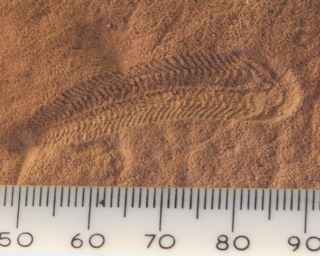
Spriggina is a genus of early bilaterian animals whose relationship to living animals is unclear. Fossils of Spriggina are known from the late Ediacaran period in what is now South Australia. Spriggina floundersi is the official fossil emblem of South Australia. It has been found nowhere else. The organism reached about 3–5 centimetres (1.2–2.0 in) in length and may have been predatory. Its bottom was covered with two rows of tough interlocking plates, while one row covered its top; its front few segments fused to form a "head."

Yorgia waggoneri is a discoid Ediacaran organism. It has a low, segmented body consisting of a short wide "head", no appendages, and a long body region, reaching a maximum length of 25 cm (9.8 in). It is classified within the extinct animal phylum Proarticulata.
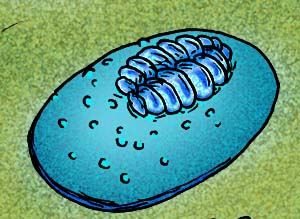
Cephalonega stepanovi is a fossil organism from Ediacaran deposits of the Arkhangelsk Region, Russia. It was described by Mikhail A. Fedonkin in 1976

Rangea is a frond-like Ediacaran fossil with six-fold radial symmetry. It is the type genus of the rangeomorphs.
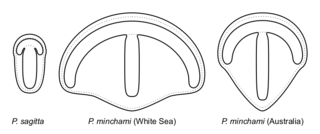
Parvancorina is a genus of shield-shaped bilaterally symmetrical fossil animal that lived in the late Ediacaran seafloor. It has some superficial similarities with the Cambrian trilobite-like arthropods.

Vendia is a genus of oval-shaped, Ediacaran fossils ranging from 4.5 to 12.5 mm long. The body is completely segmented into isomers, which are arranged alternately in two rows longitudinal to the axis of the body. The larger isomers cover the smaller ones externally but the posterior ends of all the isomers remain free. The transverse elements decrease in size from anterior to posterior and are all inclined in the same direction.

Swartpuntia is a monospecific genus of erniettomorph from the terminal Ediacaran period, with at least three quilted, leaf-shaped petaloids — probably five or six. The petaloids comprise vertical sheets of tubes filled with sand. Swartpuntia specimens range in length from 12 to 19 cm, and in width from 11.5 to 140 cm. The margin is serrated, with a 1 mm wide groove. A 14 mm wide stem extends down the middle, tapering towards the top, and stopping 25 mm from the tip. The stem has a V shaped ornamentation on it. The original fossils were found at, and named after, the Swartpunt farm between Aus and Rosh Pinah in Namibia. The generic name comes from Swartpunt, meaning black point in reference to the colour of the rocks. The specific name germsi honours Gerard Germs, who studied the Nama formation of geological beds.
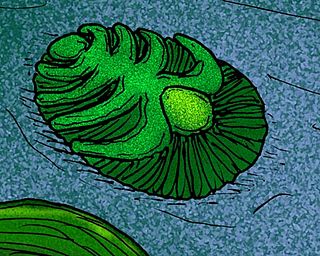
Praecambridium sigillum is an extinct organism that superficially resembles a segmented trilobite-like arthropod. It was originally described as being a trilobite-like arthropod, though the majority of experts now place it within the Proarticulata as a close relative of the much larger Yorgia. It is from the Late Ediacaran deposit of Ediacara Hills, Australia, about 555 million years ago. On average, P. sigillum had at least 5 pairs of segments, with each unit becoming progressively larger as they approach the cephalon-like head.

The Ediacaranbiota is a taxonomic period classification that consists of all life forms that were present on Earth during the Ediacaran Period. These were composed of enigmatic tubular and frond-shaped, mostly sessile, organisms. Trace fossils of these organisms have been found worldwide, and represent the earliest known complex multicellular organisms.
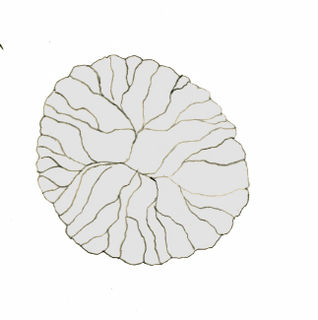
Rugoconites is a genus of Ediacaran biota found as fossils in the form of a circular or oval-like impression preserved in high relief, six or more centimeters in diameter. The fossils are surrounded by frills that have been interpreted as sets of tentacles. The bifurcating radial ribs, spreading from a central dome, serve to distinguish this genus from the sponge Palaeophragmodictya, and may represent the channels of the gastrovascular system. Fossils of Rugoconites have been interpreted as early sponges, although this is countered by Sepkoski et al. (2002), who interpreted the organism as a free-swimming jellyfish-like cnidarian; similar to Ovatoscutum. However, the fossil is consistently preserved as a neat circular form and its general morphology does not vary, therefore a benthic and perhaps slow-moving or sessile lifestyle is more likely. Ivantstov & Fedonkin (2002), suggest that Rugoconites may possess tri-radial symmetry and be a member of the Trilobozoa.

Vendiamorpha is a class of extinct animals within the Ediacaran phylum Proarticulata.

Eoandromeda is an Ediacaran organism consisting of eight radial spiral arms, and known from two taphonomic modes: the standard Ediacara type preservation in Australia, and as carbonaceous compressions from the Doushantuo formation of China, where it is abundant.

Andiva ivantsovi is a Vendian fossil, identified to be a bilaterian triploblastic animal in the Ediacaran phylum Proarticulata, known from the Winter Coast, White Sea, Russia. It was first discovered in 1977, and described as a new species in a new genus by Mikhail Fedonkin in 2002. It lived about 555 million years ago. Fossils of Andiva also occur in South Australia. All known fossils of Andiva are external molds.
Beltanelloides is a genus of marine microorganisms, known from Vendian (Ediacaran) macrofossils and found in sedimentary rocks of the White Sea, Ukraine and the Puncoviscana Formation in Argentina. The first finding of prints of the Vendian Beltanelloides sorichevae Sokolov 1965 in the lower part of the Barakun Formation confirms the Vendian age of the Far Taiga Group, Patom Complex. This finding also raises a problem concerning the lower propagation limit of Beltanelloides sorichevae. Analyzing the character of burial of Beltanelloides podolicus, Ishchenko concluded that, at early ontogenetic stages, these organisms were free floating and, then, they probably settled down on the bottom.
Studenicia is a genus of Ediacaran fauna which is approximately 635-545 million years old. All Ediacaran fauna are considered to be invertebrate Metazoans or multicellular organisms with no backbone.
References
- 1 2 3 4 Palij, V. M. (1979). "Soft-bodied Metazoa and trace fossils of Vendian and Lower Cambrian, in: Keller, B. M., Rozanov, A. Yu., (Eds.), Upper Precambrian and Cambrian Paleontology of East-European Platform". Nauka, Moskva: 49–82.
- 1 2 3 4 5 Мєнасова, A. (2011). "Деякі Закономірності Вертикального Поширення Викопної Фауни Відкладів Венду Поділля". Геологія.
- 1 2 3 4 5 6 7 Ivantsov, A. Yu. (2018). "Upper Vendian Macrofossils of Eastern Europe. Middle and Southern Ural". Borissiak Paleontological Institute and Russian Academy of Sciences, Moscow.
- 1 2 3 4 5 6 7 8 9 10 11 12 Muscente, A. D. (2019). "Ediacaran biozones identified with network analysis provide evidence for pulsed extinctions of early complex life". Nature Communications. 10 (1): 911. doi:10.1038/s41467-019-08837-3. PMC 6384941 . PMID 30796215.
- 1 2 3 4 Yevheniia, S. (2018). "Évolution des environnements sédimentaires du bassin de Podolya (Ukraine) à l'avènement des premiers métazoaires édiacariens". Géologie appliquée.